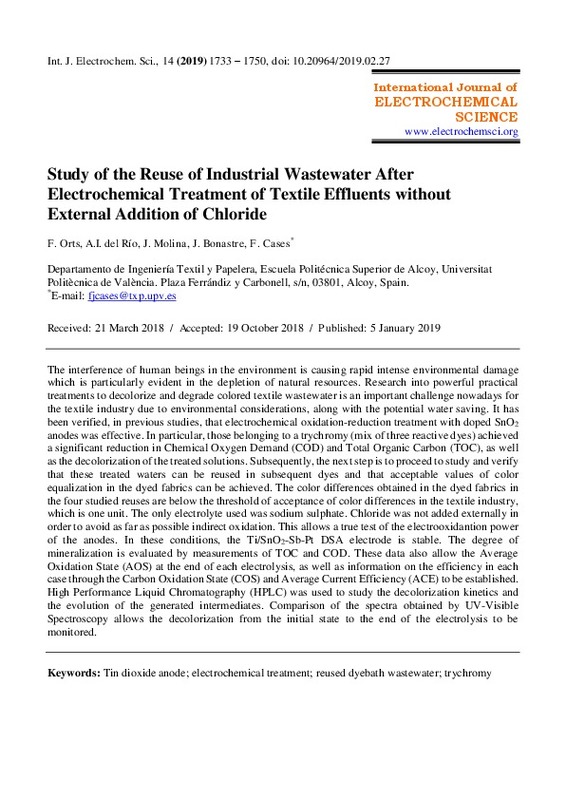JavaScript is disabled for your browser. Some features of this site may not work without it.
Buscar en RiuNet
Listar
Mi cuenta
Estadísticas
Ayuda RiuNet
Admin. UPV
Study of the Reuse of Industrial Wastewater After Electrochemical Treatment of Textile Effluents without External Addition of Chloride
Mostrar el registro sencillo del ítem
Ficheros en el ítem
| dc.contributor.author | Orts Maiques, Francisco José
|
es_ES |
| dc.contributor.author | Del Río García, Ana Isabel
|
es_ES |
| dc.contributor.author | Molina Puerto, Javier
|
es_ES |
| dc.contributor.author | Bonastre Cano, José Antonio
|
es_ES |
| dc.contributor.author | Cases, Francisco
|
|
| dc.date.accessioned | 2019-01-16T21:04:22Z | |
| dc.date.available | 2019-01-16T21:04:22Z | |
| dc.date.issued | 2019 | es_ES |
| dc.identifier.uri | http://hdl.handle.net/10251/115614 | |
| dc.description.abstract | [EN] The interference of human beings in the environment is causing rapid intense environmental damage which is particularly evident in the depletion of natural resources. Research into powerful practical treatments to decolorize and degrade colored textile wastewater is an important challenge nowadays for the textile industry due to environmental considerations, along with the potential water saving. It has been verified, in previous studies, that electrochemical oxidation-reduction treatment with doped SnO2 anodes was effective. In particular, those belonging to a trychromy (mix of three reactive dyes) achieved a significant reduction in Chemical Oxygen Demand (COD) and Total Organic Carbon (TOC), as well as the decolorization of the treated solutions. Subsequently, the next step is to proceed to study and verify that these treated waters can be reused in subsequent dyes and that acceptable values of color equalization in the dyed fabrics can be achieved. The color differences obtained in the dyed fabrics in the four studied reuses are below the threshold of acceptance of color differences in the textile industry, which is one unit. The only electrolyte used was sodium sulphate. Chloride was not added externally in order to avoid as far as possible indirect oxidation. This allows a true test of the electrooxidantion power of the anodes. In these conditions, the Ti/SnO2-Sb-Pt DSA electrode is stable. The degree of mineralization is evaluated by measurements of TOC and COD. These data also allow the Average Oxidation State (AOS) at the end of each electrolysis, as well as information on the efficiency in each case through the Carbon Oxidation State (COS) and Average Current Efficiency (ACE) to be established. High Performance Liquid Chromatography (HPLC) was used to study the decolorization kinetics and the evolution of the generated intermediates. Comparison of the spectra obtained by UV-Visible Spectroscopy allows the decolorization from the initial state to the end of the electrolysis to be monitored. | es_ES |
| dc.description.sponsorship | The authors wish to thank the Spanish Agencia Estatal de Investigación (AEI) and European Union (FEDER funds) for the financial support (contract MAT2016-77742-C2-1-P). The authors wish to acknowledge Tim Vickers for help with the English revision and Texcoy S.L. company (Spain) where the dyeing processes were done. | |
| dc.language | Inglés | es_ES |
| dc.publisher | Electrochemical Science Group | es_ES |
| dc.relation.ispartof | International Journal of Electrochemical Science | es_ES |
| dc.rights | Reconocimiento (by) | es_ES |
| dc.subject | Reused dyebath wastewater | es_ES |
| dc.subject | Trychromy | es_ES |
| dc.subject | Electrochemical treatment | es_ES |
| dc.subject | Tin dioxide anode | es_ES |
| dc.subject.classification | QUIMICA FISICA | es_ES |
| dc.subject.classification | INGENIERIA QUIMICA | es_ES |
| dc.subject.classification | INGENIERIA TEXTIL Y PAPELERA | es_ES |
| dc.title | Study of the Reuse of Industrial Wastewater After Electrochemical Treatment of Textile Effluents without External Addition of Chloride | es_ES |
| dc.type | Artículo | es_ES |
| dc.identifier.doi | 10.20964/2019.02.27 | es_ES |
| dc.relation.projectID | info:eu-repo/grantAgreement/MINECO//MAT2016-77742-C2-1-P/ES/DESARROLLO DE MATERIALES POROSOS 2D Y 3D CON APLICACIONES ELECTROQUIMICAS, CATALITICAS, TERMICAS Y BIOMEDICAS/ | es_ES |
| dc.rights.accessRights | Abierto | es_ES |
| dc.contributor.affiliation | Universitat Politècnica de València. Departamento de Ingeniería Textil y Papelera - Departament d'Enginyeria Tèxtil i Paperera | es_ES |
| dc.contributor.affiliation | Universitat Politècnica de València. Departamento de Ingeniería Química y Nuclear - Departament d'Enginyeria Química i Nuclear | es_ES |
| dc.description.bibliographicCitation | Orts Maiques, FJ.; Del Río García, AI.; Molina Puerto, J.; Bonastre Cano, JA.; Cases, F. (2019). Study of the Reuse of Industrial Wastewater After Electrochemical Treatment of Textile Effluents without External Addition of Chloride. International Journal of Electrochemical Science. 14(2):1733-1750. https://doi.org/10.20964/2019.02.27 | es_ES |
| dc.description.accrualMethod | S | es_ES |
| dc.relation.publisherversion | http://doi.org/10.20964/2019.02.27 | es_ES |
| dc.description.upvformatpinicio | 1733 | es_ES |
| dc.description.upvformatpfin | 1750 | es_ES |
| dc.type.version | info:eu-repo/semantics/publishedVersion | es_ES |
| dc.description.volume | 14 | es_ES |
| dc.description.issue | 2 | es_ES |
| dc.identifier.eissn | 1452-3981 | es_ES |
| dc.relation.pasarela | S\371274 | es_ES |
| dc.contributor.funder | Ministerio de Economía y Competitividad | es_ES |








